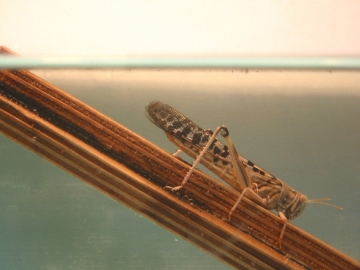



With a common name like "desert locust", you would expect Schistocerca gregaria (the locust mainly featured in this web site) to avoid water as much as possible. We were therefore very surprised to find that locusts are perfectly prepared to enter water and go for a swim, or even to walk under water.
We put locusts on an "island" platform in a tank of water, expecting them to either stay where they were, or to jump to another platform or out of the tank. Almost all the locusts we tried this with at some point just walked off the platform, down the platform support, across the bottom of the tank and up the other side to the other platform. Some of them stayed under the water for as long as 8 minutes, before re-surfacing with no apparent ill effects.
  |
|
  |
A series of images taken a few seconds apart show a locust submerging itself
The video below shows an actual example of an underwater trip!
Our observations are lab-based, and we don't know whether or why locusts would do this sort of thing in the wild. But perhaps they feed on grass submerged in temporary puddles after heavy rainfall, or maybe they just sometimes need to cross streams, and choose to walk across the bottom rather than risk a jump falling short and being swept away by the water.
(Heitler, et al., 2005, "Underwater locomotion in the deseart locust: Behavioural choice when confronted with an aquatic barrier". J. Insect Behav. 18; 669-683)
Some grasshoppers get infested by a parasite that changes their behaviour completely. The hairworm Spinochordodes tellinii has a parasitic juvenile form that develops inside normal land-loving grasshoppers, and turns them into suicidal water-loving grasshoppers. The infected grasshoppers plunge into streams or ponds and drown. The parasites then emerge as free-living adults, and live happily in the water, eventually mating and laying eggs. The eggs get eaten by some animal that feeds from the water, but they pass straight through this intermediate ("paratenic") host and get deposited on grass. Grasshoppers then get infected by eating the eggs along with the grass, and so the cycle repeats.
The parasite releases some chemical into the grasshopper that alters its brain somehow - but it's amazing that the effect is so specific. Current studies are trying to identify the chemical, and how it works.
(Biron, et al., 2005, "Behavioural manipulation in a grasshopper harbouring hairworm: a proteomics approach". Proc. Roy. Soc. B. 272; 2117-2126)